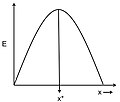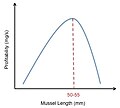Optimal foraging theory

Optimal foraging theory (OFT) is a behavioral ecology model that helps explain why animals behave the way they do when searching for food. Although initially applied to animal behavior, the principles of OFT have since been extended to understand human foraging behaviors as well. The theory proposes that organisms forage in such a way as to maximize their net energy intake per unit of time. In essence, animals are hypothesized to make decisions that provide the most energy while expending the least amount of effort.
Overview[edit]
The concept of OFT is rooted in the idea that due to the limitations of time and energy, foragers must make choices that optimize their energy gain. This involves decisions on what food to eat, where to find it, and how much time to spend searching or handling food. The theory is built on the premise that natural selection has favored foraging behaviors that maximize energy efficiency, leading to the evolution of optimal diets and foraging strategies.
Key Concepts[edit]
Energy Maximization[edit]
At the heart of OFT is the principle of energy maximization, which suggests that foragers aim to maximize their energy intake per unit of time spent foraging. This involves selecting food items that offer the highest energy yield while requiring the least amount of time to find and consume.
The Marginal Value Theorem[edit]
The Marginal Value Theorem (MVT) is a critical component of OFT, providing a model to predict how long a forager should exploit a food patch before moving on to another. According to MVT, a forager should leave a patch when the rate of energy gain drops below the average rate for the entire habitat, balancing the time spent traveling between patches and the time spent foraging within them.
Diet Selection[edit]
Diet selection models within OFT predict that foragers should prefer food items that maximize their net energy intake. This involves a trade-off between the nutritional value of available food items and the time and effort required to obtain them.
Applications[edit]
OFT has been applied to a wide range of organisms, from insects to mammals, including humans. In non-human animals, it has been used to explain behaviors such as prey selection, patch choice, and time allocation in foraging. In humans, OFT has been applied to understand hunter-gatherer food choices and agricultural practices.
Criticisms and Limitations[edit]
While OFT has been influential in the field of behavioral ecology, it has faced criticism for oversimplifying the complex decision-making processes involved in foraging. Critics argue that it often fails to account for factors such as risk, learning, and social influences. Additionally, the assumption that animals always forage optimally has been questioned, as it may not always be possible for animals to assess and act on all available information.
Conclusion[edit]
Optimal foraging theory offers a valuable framework for understanding the foraging behavior of animals, including humans. Despite its limitations and the challenges in testing its predictions, OFT continues to be a fundamental concept in behavioral ecology, providing insights into the evolutionary pressures that shape foraging strategies.

Optimal_foraging_theory[edit]
-
Bee foraging on a flower
-
SDY1
-
SDY2
-
Marginal value theorem
-
SDY4
-
SDY3
Ad. Transform your life with W8MD's Budget GLP-1 injections from $75


W8MD offers a medical weight loss program to lose weight in Philadelphia. Our physician-supervised medical weight loss provides:
- Weight loss injections in NYC (generic and brand names):
- Zepbound / Mounjaro, Wegovy / Ozempic, Saxenda
- Most insurances accepted or discounted self-pay rates. We will obtain insurance prior authorizations if needed.
- Generic GLP1 weight loss injections from $75 for the starting dose.
- Also offer prescription weight loss medications including Phentermine, Qsymia, Diethylpropion, Contrave etc.
NYC weight loss doctor appointmentsNYC weight loss doctor appointments
Start your NYC weight loss journey today at our NYC medical weight loss and Philadelphia medical weight loss clinics.
- Call 718-946-5500 to lose weight in NYC or for medical weight loss in Philadelphia 215-676-2334.
- Tags:NYC medical weight loss, Philadelphia lose weight Zepbound NYC, Budget GLP1 weight loss injections, Wegovy Philadelphia, Wegovy NYC, Philadelphia medical weight loss, Brookly weight loss and Wegovy NYC
|
WikiMD's Wellness Encyclopedia |
| Let Food Be Thy Medicine Medicine Thy Food - Hippocrates |
Medical Disclaimer: WikiMD is not a substitute for professional medical advice. The information on WikiMD is provided as an information resource only, may be incorrect, outdated or misleading, and is not to be used or relied on for any diagnostic or treatment purposes. Please consult your health care provider before making any healthcare decisions or for guidance about a specific medical condition. WikiMD expressly disclaims responsibility, and shall have no liability, for any damages, loss, injury, or liability whatsoever suffered as a result of your reliance on the information contained in this site. By visiting this site you agree to the foregoing terms and conditions, which may from time to time be changed or supplemented by WikiMD. If you do not agree to the foregoing terms and conditions, you should not enter or use this site. See full disclaimer.
Credits:Most images are courtesy of Wikimedia commons, and templates, categories Wikipedia, licensed under CC BY SA or similar.
Translate this page: - East Asian
中文,
日本,
한국어,
South Asian
हिन्दी,
தமிழ்,
తెలుగు,
Urdu,
ಕನ್ನಡ,
Southeast Asian
Indonesian,
Vietnamese,
Thai,
မြန်မာဘာသာ,
বাংলা
European
español,
Deutsch,
français,
Greek,
português do Brasil,
polski,
română,
русский,
Nederlands,
norsk,
svenska,
suomi,
Italian
Middle Eastern & African
عربى,
Turkish,
Persian,
Hebrew,
Afrikaans,
isiZulu,
Kiswahili,
Other
Bulgarian,
Hungarian,
Czech,
Swedish,
മലയാളം,
मराठी,
ਪੰਜਾਬੀ,
ગુજરાતી,
Portuguese,
Ukrainian





